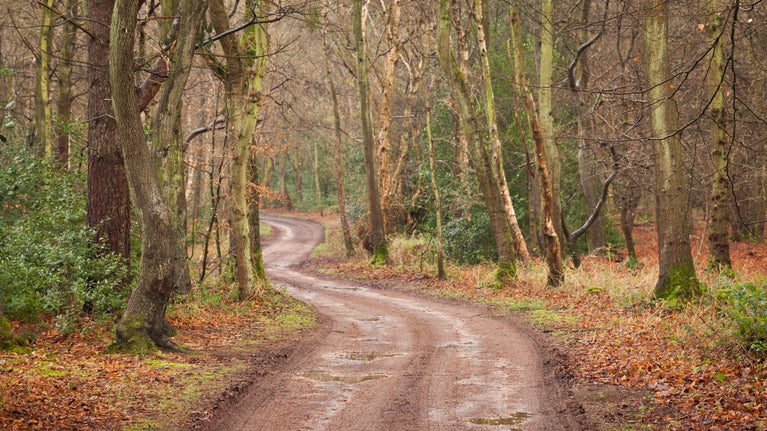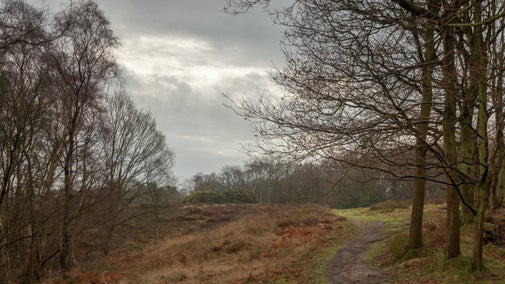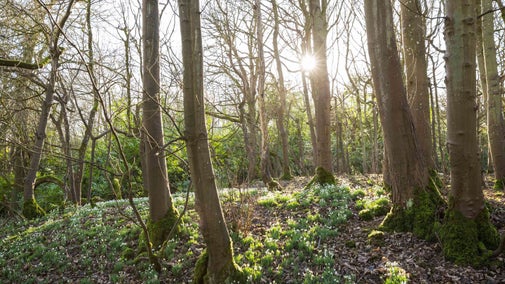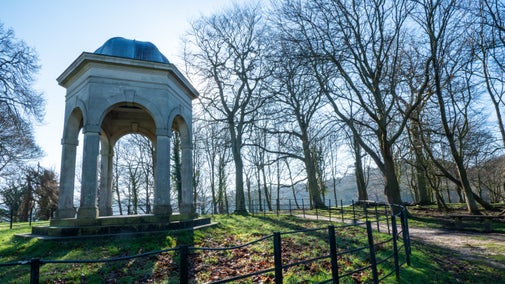
Discover more at West Runton
Find out how to get to West Runton, where to park, the things to see and do and more.

Explore West Runton and Beeston Regis Heath and you'll discover expansive sea views and a landscape teeming with wildlife, from nightjars and badgers to adders and white admiral butterflies.
Winter is a magical time to explore a different side to the woods and the heathland. The woods take on a whole new character, when autumn hues fade, making way for spectacular frosty landscapes.
The trees are laid bare, and there is a remarkable amount of wildlife activity. Watch out for winter migrants including redwings, fieldfares, bramblings, woodcocks and crossbills

Why not take a gentle walk in the woods? There are lots of paths to follow. While you're walking, look out for rowan, oak, ash and sweet chestnut, as well as old beech trees, some of which have been pollarded.
Many of the trees you will see started growing here when myxomatosis decimated the rabbit population and the windblown seeds from silver birch grew into young trees that shaded out heathland species.
The woodlands provide cover for common birds and deer. Muntjac deer are often seen, while roe and red deer are visible occasionally.
The heaths here are diverse but the dominant plant is common heather. In the warmer months you may see lizards, adders, grass snakes, toads, green woodpeckers and, at dusk, nightjars. Butterflies are less numerous in the colder months.
Looking from Roman Camp over West Runton Heath the North Sea looks deceptively inviting. In the distance you can see Holy Trinity Church in West Runton.
Climb to the top of Incleborough Hill for panoramic views of North Norfolk, the coast and the North Sea, with its wind turbines and vessels. Look up and you may see birds of prey circling such as red kites and other raptors soaring overhead.
You may also come across evidence of earthworks that were constructed during WWII. These include practice trenches, weapons pits and gun emplacements, all visible on aerial photographs. It's rumoured that there were underground tunnels and possibly a command post on the top of the hill, as it provides a clear panoramic view of potential enemy activities.

One of the aims for this area is to encourage a diverse range of plants, insects and animals. You will see many common species amongst the wildlife as well as much rarer ones, especially during the spring and autumn migrations.
Nightjars arrive in spring, making their curious churring call at dusk. If you are very lucky you might see them flying around catching insects. Other birds you may see include woodpeckers, nuthatches and finches. Buzzards and sparrowhawks are often seen soaring above the high ground, especially over Incleborough Hill.
On the heaths you could come across adders basking in the sun. Please do not attempt to handle them. Adders have poor eyesight and react to vibration, which they sense through their bodies, and they detect scent using their tongues. Common lizards and slow-worms live here too, but they're often difficult to see.
During the nesting season and on hot summer days we ask that you keep dogs on leads to avoid disturbing basking adders and ground-nesting birds such as nightjars.

You might be lucky enough to see a badger, however they normally stay in their underground setts during the day. Sometimes their presence is given away by the small pits they leave behind after digging for insect grubs and roots.
You can see several species of bat around dusk, when they feed on the plentiful insects. The most commonly seen are pipistrelles and brown long-eared bats, but you might also see a Natterer's bat. Occasionally noctules and serotines are are spotted flying high over the open areas.
While strolling the heaths, keep an eye out for the barred chestnut moth (rare in Norfolk), hummingbird hawk moth, silver-washed fritillary and the day-flying broad-bordered bee hawk moth. Green hairstreak and grayling butterflies are also found on the heaths.
One of the most notable butterflies is the white admiral. It glides along the forest rides in July, from trees to the woodland floor. The species is still spreading northwards and climate change is thought to be partly the cause of this. You can often see these butterflies around honeysuckle where they lay their eggs, as their larvae feed on the plant.

A beetle that you might come across is the green tiger beetle (Cicindela campestris). This is the only common and widespread tiger beetle species in the UK. They can be found across a range of heathlands, and can be spotted from April to September.
You can easily recognise these ground beetles by their iridescent green bodies with yellow spots. Notice their long legs, which help to make them agile when hunting for prey. Their large eyes are great for spying potential food. The larvae live in burrows and are often responsible for the little holes you may see on the heathland.
The only other tiger beetle you might see in Norfolk is the dune tiger beetle (Cicindela maritima).
West Runton is home to many species of flowers. How many will you spot on your next visit?
You can see foxgloves both in shady woodlands and on the heaths. They flower from early summer to the autumn and the tall flower spikes are produced in the plant's second year.
The red campion has a bright rose-red flower and a hairy stem and leaves. You will spot them under hedges and in woodlands. In the woodland they usually come into flower as the bluebells start to fade.
The bugle has deep blue flower spikes and blooms between April and July. It attracts a variety of insects.
Gorse bushes cover the Main Heath and Incelborough Hill. These coconut-scented plants flower in late autumn through winter, reaching their peak in spring.

Find out how to get to West Runton, where to park, the things to see and do and more.
Dogs are very welcome at West Runton and Beeston Regis Heath. Find out the things to be aware of when you visit, the facilities available for your dog and more.

Walk through West Runton and Beeston Regis Heath and you'll discover several clues about its history, from iron ore pits to a Napoleonic War-era coastal signal station.

Plan a visit to one of the special countryside places in our care and discover the benefits of being in the great outdoors. Pack your walking boots and get ready to explore woodlands, valleys and rivers.

Explore an array of woodlands, bridleways, trails and paths throughout the countryside in Norfolk, with plentiful to spot wildlife along the way.

Explore some of the finest landscapes in our care on coastal paths, accessible trails, woodland walks and everything in between. Find the best places to walk near you.
